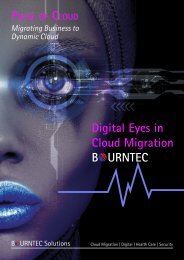Bourntec Informatica To ODI Enabler
Create successful ePaper yourself
Turn your PDF publications into a flip-book with our unique Google optimized e-Paper software.
B URNTEC <strong>Informatica</strong> to <strong>ODI</strong> Transformation<br />
for <strong>Enabler</strong><br />
<strong>Bourntec</strong>‘s pre-built, pre-tested <strong>ODI</strong> and cloud-based architecture is a strategic<br />
decision guide and implementation accelerator that improves application quality,<br />
lowers IT cost and speeds deploymen<br />
<strong>ODI</strong> Transition -<br />
<strong>Informatica</strong> and Oracle<br />
<strong>Informatica</strong> has long been recognized<br />
as one of the market leader for Data<br />
Integration. Many companies have invested<br />
in <strong>Informatica</strong> to run side by side with their<br />
Oracle applications and business intelligence<br />
reporting. Oracle’s comprehensive data<br />
integration platform is rapidly gaining<br />
market share from <strong>Informatica</strong> and is<br />
considered a market leader from both an<br />
adoption and market growth perspective.<br />
<strong>ODI</strong>’s E-LT (vs. ETL) approach helps<br />
companies improve performance while<br />
reducing cost; a very attractive offer for<br />
companies that use <strong>Informatica</strong> and Oracle<br />
together today to manage seamless data<br />
flows between disparate systems or extend<br />
the base offering of the Oracle Business<br />
Intelligence applications. So, what is keeping<br />
your enterprise from taking advantage<br />
of <strong>ODI</strong>? The sheer number of <strong>Informatica</strong><br />
mappings you have that need to be<br />
converted? Or the business reliance on the<br />
additional data mapped into Oracle Business<br />
Intelligence with <strong>Informatica</strong>?<br />
Challenges and Migration<br />
Opportunities:<br />
Given the importance of data in the modern<br />
enterprise, a flawed data migration can<br />
have severe repercussions. Understanding<br />
of the various challenges in Data migration<br />
is required to mitigate many of the risks<br />
associated.<br />
1. Data Integration is the process of<br />
identifying ways to bring data from<br />
disparate sources and combining them<br />
to have a unified view. Well, that is a<br />
challenging task by itself.<br />
2. From a technical standpoint, the<br />
technical aspect of this implementation is<br />
the first level of challenge. It is never easy<br />
to understand data residing in disparate<br />
sources and then design a common<br />
structure to fit them all at one place.<br />
The tool selection is also very important to<br />
the overall success of any data integration<br />
project. A feasibility study should be<br />
performed to select the right toolset for the<br />
job. Small enterprises or companies who are<br />
just starting their data warehousing initiative<br />
are faced with this challenge and sometimes,<br />
making that decision isn’t easy considering<br />
the number of options available today.<br />
Solutions to Manage Data<br />
Migration Effectively<br />
Choosing the right technology/tool stack<br />
is one of the biggest decisions that awaits<br />
the migration team. The choices range from<br />
a custom built solution, data integration<br />
tools to a hybrid solution. While there<br />
are merits and drawbacks to each choice,<br />
the flexibility and comprehensive data<br />
integration capabilities offered by modern<br />
ELT tools makes them a compelling choice.<br />
Many of these tools offer integrated<br />
development environments that speed<br />
up the development process and provide<br />
plenty of customization capabilities through<br />
scripting/reusability.<br />
The data migration solution offered by<br />
<strong>Bourntec</strong> provides a robust data integration<br />
toolkit and Java/Perl based scripting<br />
allowing for significant customization. Other<br />
technology challenges include differences<br />
between the underlying source/target<br />
database systems (mismatches in terms<br />
of data types supported, date/time format<br />
mismatches etc), encrypted data, and<br />
handling of character encoding and numeric<br />
precision.<br />
B URNTEC <strong>Informatica</strong> to <strong>ODI</strong><br />
B URNTEC<br />
<strong>Informatica</strong> on Premise<br />
<strong>Informatica</strong> Dashboard<br />
B URNTEC<br />
<strong>Informatica</strong> Database<br />
<strong>Informatica</strong> Security<br />
<strong>Informatica</strong> Datagrid<br />
On premise<br />
On premise<br />
Sales, Service, Marketing,<br />
Communities, Analytics, Platform<br />
B URNTEC<br />
<strong>Enabler</strong><br />
Replication<br />
Replication<br />
Synchronization<br />
B URNTEC<br />
<strong>ODI</strong> in Cloud<br />
Oracle Data Integrator in Cloud<br />
• <strong>ODI</strong><br />
• DBaaS<br />
• Cloud<br />
Cloud<br />
Cloud



